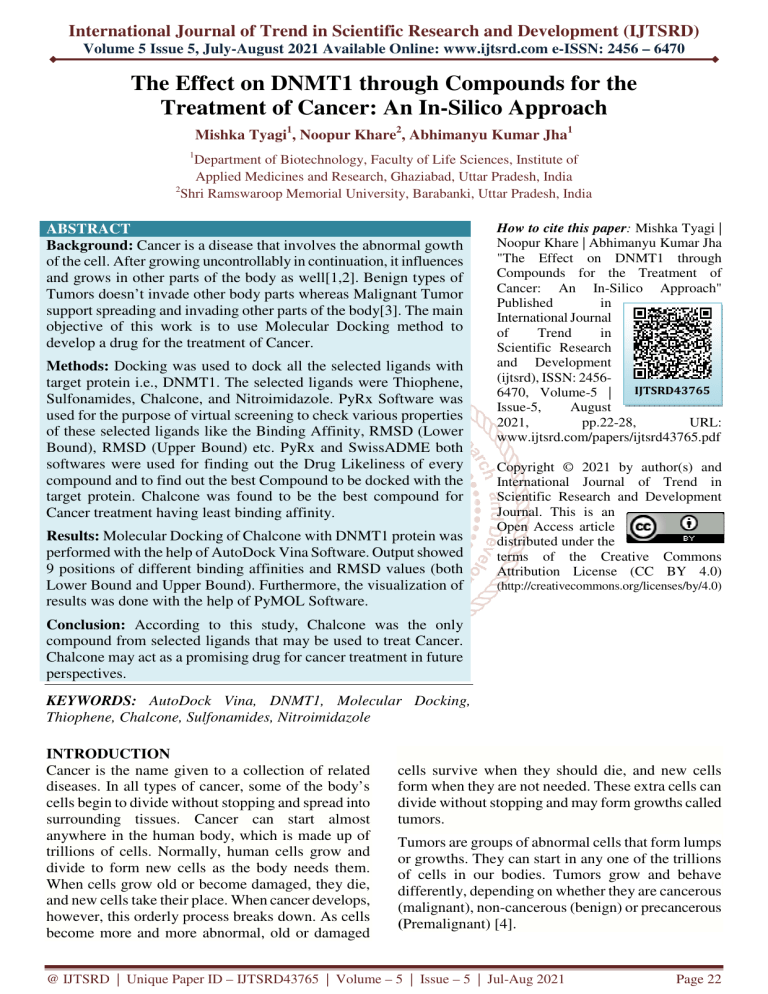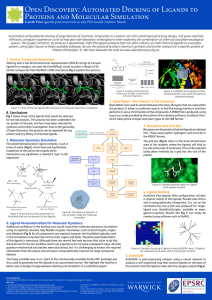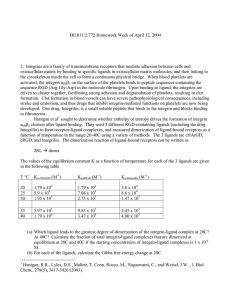
International Journal of Trend in Scientific Research and Development (IJTSRD)
Volume 5 Issue 5, July-August 2021 Available Online: www.ijtsrd.com e-ISSN: 2456 – 6470
The Effect on DNMT1 through Compounds for the
Treatment of Cancer: An In-Silico Approach
Mishka Tyagi1, Noopur Khare2, Abhimanyu Kumar Jha1
1
Department of Biotechnology, Faculty of Life Sciences, Institute of
Applied Medicines and Research, Ghaziabad, Uttar Pradesh, India
2
Shri Ramswaroop Memorial University, Barabanki, Uttar Pradesh, India
ABSTRACT
Background: Cancer is a disease that involves the abnormal gowth
of the cell. After growing uncontrollably in continuation, it influences
and grows in other parts of the body as well[1,2]. Benign types of
Tumors doesn’t invade other body parts whereas Malignant Tumor
support spreading and invading other parts of the body[3]. The main
objective of this work is to use Molecular Docking method to
develop a drug for the treatment of Cancer.
Methods: Docking was used to dock all the selected ligands with
target protein i.e., DNMT1. The selected ligands were Thiophene,
Sulfonamides, Chalcone, and Nitroimidazole. PyRx Software was
used for the purpose of virtual screening to check various properties
of these selected ligands like the Binding Affinity, RMSD (Lower
Bound), RMSD (Upper Bound) etc. PyRx and SwissADME both
softwares were used for finding out the Drug Likeliness of every
compound and to find out the best Compound to be docked with the
target protein. Chalcone was found to be the best compound for
Cancer treatment having least binding affinity.
Results: Molecular Docking of Chalcone with DNMT1 protein was
performed with the help of AutoDock Vina Software. Output showed
9 positions of different binding affinities and RMSD values (both
Lower Bound and Upper Bound). Furthermore, the visualization of
results was done with the help of PyMOL Software.
How to cite this paper: Mishka Tyagi |
Noopur Khare | Abhimanyu Kumar Jha
"The Effect on DNMT1 through
Compounds for the Treatment of
Cancer: An In-Silico Approach"
Published
in
International Journal
of
Trend
in
Scientific Research
and Development
(ijtsrd), ISSN: 2456IJTSRD43765
6470, Volume-5 |
Issue-5,
August
2021,
pp.22-28,
URL:
www.ijtsrd.com/papers/ijtsrd43765.pdf
Copyright © 2021 by author(s) and
International Journal of Trend in
Scientific Research and Development
Journal. This is an
Open Access article
distributed under the
terms of the Creative Commons
Attribution License (CC BY 4.0)
(http://creativecommons.org/licenses/by/4.0)
Conclusion: According to this study, Chalcone was the only
compound from selected ligands that may be used to treat Cancer.
Chalcone may act as a promising drug for cancer treatment in future
perspectives.
KEYWORDS: AutoDock Vina, DNMT1, Molecular Docking,
Thiophene, Chalcone, Sulfonamides, Nitroimidazole
INTRODUCTION
Cancer is the name given to a collection of related
diseases. In all types of cancer, some of the body’s
cells begin to divide without stopping and spread into
surrounding tissues. Cancer can start almost
anywhere in the human body, which is made up of
trillions of cells. Normally, human cells grow and
divide to form new cells as the body needs them.
When cells grow old or become damaged, they die,
and new cells take their place. When cancer develops,
however, this orderly process breaks down. As cells
become more and more abnormal, old or damaged
cells survive when they should die, and new cells
form when they are not needed. These extra cells can
divide without stopping and may form growths called
tumors.
Tumors are groups of abnormal cells that form lumps
or growths. They can start in any one of the trillions
of cells in our bodies. Tumors grow and behave
differently, depending on whether they are cancerous
(malignant), non-cancerous (benign) or precancerous
(Premalignant) [4].
@ IJTSRD | Unique Paper ID – IJTSRD43765 | Volume – 5 | Issue – 5 | Jul-Aug 2021
Page 22
International Journal of Trend in Scientific Research and Development @ www.ijtsrd.com eISSN: 2456-6470
There are three main types of tumor:
Benign Tumor: These are not cancerous. They either
cannot spread or grow, or they do so very slowly. If a
doctor removes them, they do not generally return.
Premalignant Tumor: In these tumors, the cells are
not cancerous, but they have the potential to become
malignant.
Malignant Tumor: Malignant tumors are cancerous.
The cells can grow and spread to other parts of the
body.
Cancer is a genetic disease—that is, caused by
changes in our genes that controls our cells function,
especially how they grow and divide.
Genetic and Epigenetic changes that cause cancer can
be inherited from our parents. These changes develop
as a result of errors that occur during cell division or
because of damage to DNA caused by certain
environmental
exposures.
Cancer-causing
environmental exposures include substances, such as
the chemicals in tobacco smoke, and radiation, such
as ultraviolet rays from the sun.
Cancer is the name given to a collection of related
diseases. In all types of cancer, some of the body’s
cells begin to divide without stopping and spread into
surrounding tissues. Cancer can start almost
anywhere in the human body, which is made up of
trillions of cells. Normally, human cells grow and
divide to form new cells as the body needs them.
According to the International Agency for Research
on Cancer, in 2002, cancer killed > 6.7 million people
around the world and another 10.9 million new cases
were diagnosed. If the results are extrapolated, at the
same rate, an estimated 15 million people will have
cancer, annually, by 2020. A large portion of Cancer
disease is caused due to the Genetic mutations[3].
Other small portion includes the use of Tobacco.
In Computer Assissted Drug Designing(CADD),
Molecular Docking is an important tool playing a
major role for docking procedure. The main objective
of this docking is to search out the major modes of
binding ligand to target protein. The Successful
docking procedure follows up the good outpit making
research work successful as well.
Molecular docking is an attractive scaffold to
understand drug bio-molecular interactions for the
rational drug design and discovery, as well as in the
mechanistic study by placing a molecule (ligand) into
the preferred binding site of the target specific region
of the DNA/protein (receptor) mainly in a noncovalent fashion to form a stable complex of potential
efficacy and more specificity. The method predicts
the best binding energy with the ligand molecule
against protein.
The Aim for this experiment is to examine the active
and domain sites of DNMT1, to carry out auto
docking of target protein with the selected ligand and
to determine the their active sites and compound
docking so that we can analyze the therpeutic effect
of compound against the target protein DNMT1.
MATERIALS AND METHODS
Step -1: Identification of proteins
By studying various published literatures and research
work, disease causing protein can be retrieved
through various database. Disease causing protein
was retrieved from Uniprot. Structure of the disease
causing protein molecule was retrieved in ‘.pdb’
format from RCSB Protein Data Bank (PDB)[5].
Step - 2: Identification of Ligands
After studying the literature,4 compounds/ligands
were selected for the study of Molecular Docking.
The 4 compounds/ligands were:
1. Thiophenes
2. Sulfonamides
3. Chalcones
4. Nitroimidazole.
All these ligands were retrieved from PubChem[6].
After searching the name of compound/ligand, they
were downloaded in ‘.sdf’ format in a 3D structure
form. Thereafter, Conversion of all of the
downloaded compounds/ligands were downloaded in
‘.pdb’ format with the help of online SMILES
translator[7,8].
Step -3: Virtual Screening through PyRx
PyRx is a software that is basically used to screen
ligands with the target protein and find out their
binding affinity with the target protein. This software
runs only on ‘.pdbqt’ format. At first step of PyRx
procedure, Protein molecule was loaded & then
converted to a macromolecule. Furthermore, all the
selected ligands of ‘.pdb’ format were loaded and
then converted to ‘.pdbqt’ format. After running of
programming, screen displays resultant tables giving
details about ligands properties. Minimum binding
energy was displayed on the screen of the software
and some other details as well. Docking was
performed between the target protein and the ligand
molecule after considering the ligand with minimum
binding energy.
Step - 4: Swiss ADME
Swiss ADME is an online web server that uses
SMILE notations of ligands that were copied and
pasted from Pub Chem. With the help of this online
web server, analysis of selected ligands were done
through their drug likeliness property. In other words,
@ IJTSRD | Unique Paper ID – IJTSRD43765 | Volume – 5 | Issue – 5 | Jul-Aug 2021
Page 23
International Journal of Trend in Scientific Research and Development @ www.ijtsrd.com eISSN: 2456-6470
drug likeliness property analysis was done through
SwissADME. Basically, drugs were inspected for
Lipinski’s rule of five. Lipinski’s rule of five are as
follows:
1. H-bond donors must be <5.
2. H-bond acceptors must be <10.
3. The molecular weight must be <500 Dalton.
4. Partition co-efficient LogP must be <5.
5. Only 1 rule is authorized to be violated.
The ligand that follows all 5 rules of lipinski (as
mentioned above) is selected for the final process of
Autodocking.
Step - 5: Autodock
At first, the target protein in ‘.pdb’ format was loaded
on the homepage of Autodock. The target protein was
prepared for autodocking by following steps of
AutoDock followed by removing water molecules,
then adding hydrogens polar atoms thereafter by
adding kollman charges. After this, the protein was
selected and was saved in ‘.pdbqt’ format. Then, the
selected ligand was loaded on homepage of
AutoDock. Following the further process of
AutoDocking, Grid box was selected for the region
where docking was to be performed. Thereafter,
Command Prompt, also known as cmd, was used for
executing the results of performed AutoDock.
Step - 6: Visualization of results through PyMOL
PyMOL is a tool which is used to visualize the
molecular surface of the docked structure. In other
words, structural visualization was done with the help
of this tool. The output in ‘.pdbqt’ format was runned
in PyMOL. Molecular surface of the output was seen
on the screen.
RESULTS AND DISCUSSION
The target protein DNMT1 was downloaded from
Uniprot in ‘.pdb’ format as shown in Figure 1 with
additional details of protein in figure(b). DNMT1
belongs to transferase category. Protein resolution
was 2.31Å and the method for this protein was X-ray
diffraction. The other selected ligands were also
retrieved from the PubChem as 2D or 3D conformer
in ‘.sdf’ format which were further converted to
‘.pdb’ format by online SIMILIE .sdf to .pdb
convertor as shown in Figure 3, Figure 4, Figure 5
and Figure 6.
Figure 1: Structure of DNMT1
Protein
Name:
methyltransferase
DNA-(cytosine-5)-
Gene: DNMT1
Protein database no: 3epz
Classification: Transferase
Organism: Homo Sapiens
Expression system: Escherichia coli
Mutation: No
Figure 2: Biological assembly 1
@ IJTSRD | Unique Paper ID – IJTSRD43765 | Volume – 5 | Issue – 5 | Jul-Aug 2021
Page 24
International Journal of Trend in Scientific Research and Development @ www.ijtsrd.com eISSN: 2456-6470
Figure 6: 2D structure of Chalcone
Figure 3: Biological assembly 2
2D Structure of the selected Ligands
Figure 7: 2D structure of Nitroimidazole
3D structure of Ligands
Figure 4: 2D structure of Thiophene
Figure 8: 3D structure of Thiophene
Figure 9: 3D structure of Sulfonamides
Figure 5: 2D structure of Sulfonamide
@ IJTSRD | Unique Paper ID – IJTSRD43765 | Volume – 5 | Issue – 5 | Jul-Aug 2021
Page 25
International Journal of Trend in Scientific Research and Development @ www.ijtsrd.com eISSN: 2456-6470
Figure 10: 3D structure of Chalcone
Figure 11: 3D structure of Nitroimidazole
Table 1: Details of the Ligand molecules were retrieved from PubChem
PubChem
Molecular
Molecular
Hydrogen
Hydrogen
S. No Ligand Name
ID
weight
Formula
Bond Donor Bond Acceptor
1.
Thiophene
8030
84.14 g/mol
C4H4S
0
1
2.
Sulfonamide
5333
172.1 g/mol C6H8N2O2S
2
4
3.
Chalcone
637760
208.25 g/mol
C15H12O
0
1
4.
Nitroimidazole
10701
113.08 g/mol
C3H3N3O2
1
3
All of these selected ligands were runned and their screening was done on PyRx software. The results were
displayed on PyRx and are mentioned in Table 2 and Table 3. The binding affinity of every ligand was displayed
on the screen. The results were taken in considerations carefully and then the ligand with suitable binding
affinity was choosen for further process of auto docking. But before that, Swiss ADME was used for drug
likeliness property analysis. A compound was selected after analyzing the drug likeliness through PyRx and
Swiss ADME.
Table 2: PyRx Results showing properties of different ligands in order to dock suitable Ligand with
the Target Protein.
Selected Ligands Binding Affinity RMSD (LB) RMSD (UB)
Thiophene
-2.5
17.928
18.649
Sulfonamide
-4.7
4.335
5.652
Chalcone
-5.2
3.879
8.528
Nitroimidazole
-4.3
0.049
1.673
Table 3: Binding energy of different ligands with target protein
Ligands
Binding Energy
Thiophene
-2.5
Sulfoamide
-4.7
Chalcone
-5.2
Nitroimidazole
-4.3
Here, After studying the PyRx results, binding energy of selected ligands were concluded and noted down in a
tabular form.
Then after, these molecules were runned in Swiss ADME for inspection of drug likeliness.
Table 4: Swiss ADME Result Analysis
Name of Ligand
Mol. Wt.
H-Bond Donor H-Bond Acceptor
Thiophene
84.14 g/mol
0
0
Sulfonamide
172.20 g/mol
2
3
Chalcone
208.26 g/mol
0
1
Nitroimidazole 113.07 g/mol
1
3
Lipinski
Yes; 0 violation
Yes; 0 violation
Yes; 0 violation
Yes; 0 violation
In SwissADME, ligands were observed on the basis of Lipinski’s rule of five, its molecular weight, Hydrogen
bond donor, and Hydrogen bond acceptor. According to the SwissADME results, it was concluded that chalcone
was the most qualified ligand for Autodocking step with the target protein. It follows the lipinski’s rule of 5 as
well as showing the 0 violation.
After SwissADME, the last step was docking through AutoDock Vina. As observed from the above results,
Chalcone revealed itself as the most suitable out of these 4 selected ligands for docking with the target protein.
In Auto Docking, the target protein was docked with the selected ligand and then the output was in ‘.pdbqt’
format and was runned in command prompt.
@ IJTSRD | Unique Paper ID – IJTSRD43765 | Volume – 5 | Issue – 5 | Jul-Aug 2021
Page 26
International Journal of Trend in Scientific Research and Development @ www.ijtsrd.com eISSN: 2456-6470
Figure 12: Preparation of Grid Box
AutoDock Vina software was used to dock the ligand Chalcone with the target protein DNMT1. Table-5 reveals
Chalcone to be the best ligand to bind against DNMT1 target protein by the help of docking using Autodock
Vina.
Table 5: Results of AutoDock Vina
Mode Binding Affinity (kcal/mol) RMSD lower bound RMSD upper bound
1.
-7.6
0
0
2.
-7.3
1.766
6.559
3.
-7.1
1.374
2.321
4.
-6.6
2.964
6.693
5.
-6.3
2.010
6.578
6.
-6.3
24.647
25.858
7.
-6.2
24.877
26.170
8.
-6.1
24.199
26.751
9.
-6.0
4.618
7.656
PyMOL was used to visualize the output in ‘.pdbqt’ format.
Figure 13: Result Visualization in PyMOL
@ IJTSRD | Unique Paper ID – IJTSRD43765 | Volume – 5 | Issue – 5 | Jul-Aug 2021
Page 27
International Journal of Trend in Scientific Research and Development @ www.ijtsrd.com eISSN: 2456-6470
Figure 14: Interaction of DNMT1 with Chalcone through PyMOL visualizer
CONCLUSION
In this in silico analysis, Chalcone might act as an
inhibitor and can be utilized to act as a drug in
treatment of Cancer. Therefore, this drug may prevent
cancer and may play an effective role for cancer
treatment. Studies of docking showed that there was
the strong affinity of Chalcone towards the target
protein of cancer. It may be used in a form of drug
after in vitro and in vivo studies which may act as a
promising anti-cancer agent. This Drug may prevent
cancer by forming effective drug against cancer.
CONFLICT OF INTEREST
The Author declare that there is no conflict of interest
ACKNOWLEDGEMENT
The Authors acknowledgement the help provided by
the Department of Biotechnology, Faculty of Life
Sciences, Institute of Applied Medicines and
Research, Ghaziabad, Uttar Pradesh, India.
REFERENCES
[1] "Cancer". World Health Organization. 12
September 2018. Retrieved 19 December 2018.
[2]
"Defining Cancer". National Cancer Institute.
17 September 2007. Retrieved 28 March 2018.
[3]
"Defining Cancer". National Cancer Institute.
17 September 2007. Retrieved 28 March 2018.
[4]
Yvette Brazier, 2019, medically reviewed,
Medical
news
today,
https://www.medicalnewstoday.com/articles/24
9141.
[5]
www.rcsb.org.
[6]
https://pubchem.ncbi.nlm.nih.gov/.
[7]
https://cactus.nci.nih/translate/.
[8]
https://cactusa.nci.nih.gov/cgi-bin/translate.tcl.
@ IJTSRD | Unique Paper ID – IJTSRD43765 | Volume – 5 | Issue – 5 | Jul-Aug 2021
Page 28






